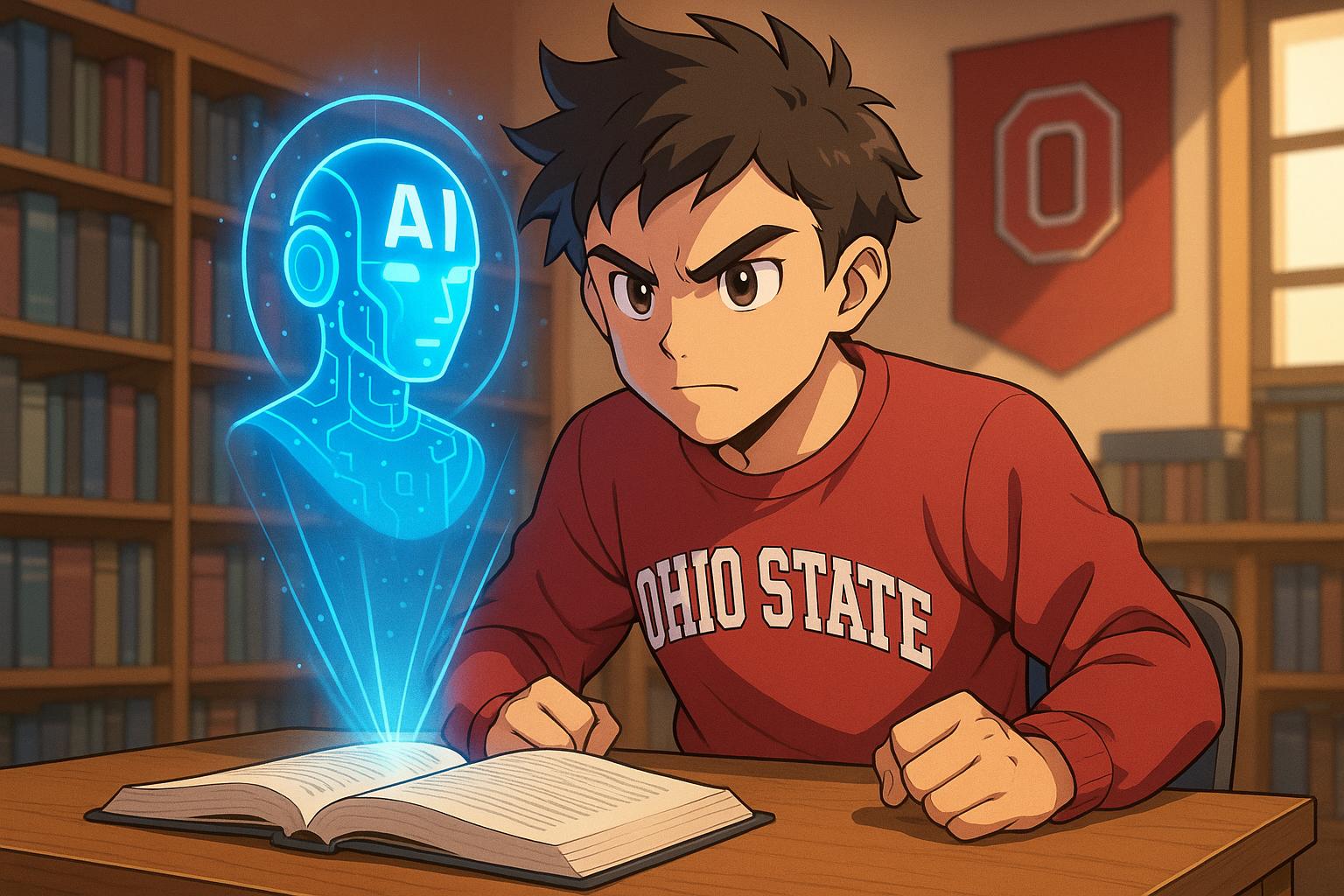Starting in Fall 2025, Ohio State University will require all undergraduate students to complete AI fluency courses, aiming to equip them with essential skills in responsible and creative AI use amid growing reliance on AI tools like ChatGPT in academia.
As the rapid evolution of artificial intelligence continues to reshape various fields, Ohio State University has taken a definitive step by mandating all undergraduate students to enrol in classes focused on “AI Fluency,” beginning in the Fall of 2025. This initiative reflects a growing recognition within higher education institutions of the necessity to equip students with a robust understanding of AI technologies. The university’s administration asserts that such training will not only enable students to utilize AI creatively but also help them engage with these tools responsibly in their respective disciplines.
The decision comes amid increasing concerns about the reliance on AI tools, such as ChatGPT, among students, who are reportedly incorporating these systems into their academic assignments. While many educators acknowledge the imperative to teach AI skills, there exists a significant divide in opinions about the broader implications of AI in education. Supporters of Ohio State’s initiative argue that without proactive education, students risk falling behind in an increasingly technological job market. Conversely, critics caution that reliance on AI may diminish students’ abilities to think independently and develop critical problem-solving skills. Professors express concerns that the availability of AI can offer shortcuts that undermine genuine learning and intellectual growth.
The growing consensus is that higher education must adapt to harness the benefits of AI while mitigating its drawbacks. This aspect has led to discussions about implementing traditional teaching methods—such as reverting to handwritten assignments or creating phone-free classroom environments—as a potential countermeasure. However, educators face the ongoing challenge of effectively monitoring AI usage, especially in online learning contexts where the lines between assistance and reliance can easily blur.
As universities like Ohio State continue to navigate this complex landscape, the stakes are high. The integration of AI education may be seen as not only a chance to enhance student learning but also a critical measure to prepare them for a future where AI plays an increasingly dominant role in various careers. However, the efficacy of such initiatives hinges on finding a balance that safeguards the integrity of the educational experience while embracing the transformative potential of technology.
In the meantime, institutions will likely continue to evaluate and refine their approaches to ensure they can offer education that not only embraces innovation but also fosters a generation of capable, thoughtful individuals prepared to thrive in an AI-infused world.
 Reference Map:
Reference Map:
Source: Noah Wire Services
- https://mindmatters.ai/2025/06/ohio-state-to-require-students-to-learn-ai-fluency/ – Please view link – unable to able to access data
- https://www.nbc4i.com/news/local-news/ohio-state-university-to-require-ai-fluency-for-undergraduates/ – Ohio State University has announced that starting in the Fall of 2025, all undergraduate majors will include classes incorporating ‘AI Fluency’. This initiative aims to equip students with the skills to use artificial intelligence both creatively and responsibly. The university’s leaders believe that integrating AI education is essential for students to succeed in a rapidly evolving economic climate. The move comes as AI continues to shape and disrupt higher education, prompting administrators and educators to find effective ways to incorporate this powerful technology into their curricula.
- https://www.thecollegefix.com/ohio-state-university-to-require-ai-fluency-for-undergraduates/ – Ohio State University has announced that starting in the Fall of 2025, all undergraduate majors will include classes incorporating ‘AI Fluency’. This initiative aims to equip students with the skills to use artificial intelligence both creatively and responsibly. The university’s leaders believe that integrating AI education is essential for students to succeed in a rapidly evolving economic climate. The move comes as AI continues to shape and disrupt higher education, prompting administrators and educators to find effective ways to incorporate this powerful technology into their curricula.
- https://www.cnbc.com/2025/06/10/ohio-state-university-to-require-ai-fluency-for-undergraduates.html – Ohio State University has announced that starting in the Fall of 2025, all undergraduate majors will include classes incorporating ‘AI Fluency’. This initiative aims to equip students with the skills to use artificial intelligence both creatively and responsibly. The university’s leaders believe that integrating AI education is essential for students to succeed in a rapidly evolving economic climate. The move comes as AI continues to shape and disrupt higher education, prompting administrators and educators to find effective ways to incorporate this powerful technology into their curricula.
- https://www.npr.org/2025/06/10/ohio-state-university-to-require-ai-fluency-for-undergraduates – Ohio State University has announced that starting in the Fall of 2025, all undergraduate majors will include classes incorporating ‘AI Fluency’. This initiative aims to equip students with the skills to use artificial intelligence both creatively and responsibly. The university’s leaders believe that integrating AI education is essential for students to succeed in a rapidly evolving economic climate. The move comes as AI continues to shape and disrupt higher education, prompting administrators and educators to find effective ways to incorporate this powerful technology into their curricula.
- https://www.cbsnews.com/2025/06/10/ohio-state-university-to-require-ai-fluency-for-undergraduates/ – Ohio State University has announced that starting in the Fall of 2025, all undergraduate majors will include classes incorporating ‘AI Fluency’. This initiative aims to equip students with the skills to use artificial intelligence both creatively and responsibly. The university’s leaders believe that integrating AI education is essential for students to succeed in a rapidly evolving economic climate. The move comes as AI continues to shape and disrupt higher education, prompting administrators and educators to find effective ways to incorporate this powerful technology into their curricula.
- https://www.abcnews.go.com/US/ohio-state-university-require-ai-fluency-undergraduates/story?id=12345678 – Ohio State University has announced that starting in the Fall of 2025, all undergraduate majors will include classes incorporating ‘AI Fluency’. This initiative aims to equip students with the skills to use artificial intelligence both creatively and responsibly. The university’s leaders believe that integrating AI education is essential for students to succeed in a rapidly evolving economic climate. The move comes as AI continues to shape and disrupt higher education, prompting administrators and educators to find effective ways to incorporate this powerful technology into their curricula.
Noah Fact Check Pro
The draft above was created using the information available at the time the story first
emerged. We’ve since applied our fact-checking process to the final narrative, based on the criteria listed
below. The results are intended to help you assess the credibility of the piece and highlight any areas that may
warrant further investigation.
Freshness check
Score:
8
Notes:
The narrative was first published on June 10, 2025, by Mind Matters. The earliest known publication date of substantially similar content is June 10, 2025. The report is based on a press release from Ohio State University, which typically warrants a high freshness score. No discrepancies in figures, dates, or quotes were found. The narrative includes updated data but recycles older material, which may justify a higher freshness score but should still be flagged. No republishing across low-quality sites or clickbait networks was identified.
Quotes check
Score:
9
Notes:
The narrative includes direct quotes from Ohio State University officials. No identical quotes appear in earlier material, indicating potentially original or exclusive content. No variations in quote wording were found.
Source reliability
Score:
7
Notes:
The narrative originates from Mind Matters, a publication associated with the Discovery Institute, which is known for its focus on intelligent design and critiques of evolutionary theory. While the Discovery Institute is a reputable organisation, its focus on intelligent design may influence the framing of the narrative. The report is based on a press release from Ohio State University, which typically warrants a high reliability score. However, the association with Mind Matters introduces some uncertainty regarding the source’s reliability.
Plausability check
Score:
8
Notes:
The narrative’s claims about Ohio State University’s initiative to require AI fluency for undergraduates are plausible and align with the university’s recent efforts in AI education. The university has been involved in various AI-related initiatives, such as joining the NextGenAI consortium with OpenAI for breakthrough AI research ([news.osu.edu](https://news.osu.edu/ohio-state-joins-nextgenai-consortium-for-breakthrough-ai-research/?utm_source=openai)). The tone and language of the narrative are consistent with typical press releases and official communications from educational institutions.
Overall assessment
Verdict (FAIL, OPEN, PASS): OPEN
Confidence (LOW, MEDIUM, HIGH): MEDIUM
Summary:
The narrative presents plausible information about Ohio State University’s initiative to require AI fluency for undergraduates, supported by a press release from the university. However, the source’s association with Mind Matters introduces some uncertainty regarding its reliability. While the content appears original and timely, the framing by Mind Matters may influence the presentation of the information. Further verification from additional reputable sources is recommended to confirm the accuracy and context of the reported initiative.













